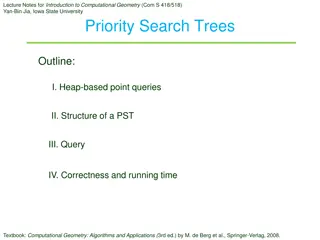Understanding Computational Geometry: Triangulations and Art Gallery Guarding
Explore the concepts of triangulations and guarding art galleries in computational geometry. Learn about the problem of placing cameras or guards strategically in an art gallery to ensure every point is visible. Discover how polygons are defined, the variations in guarding strategies, and the use of triangulations to decompose polygons for efficient guarding techniques.
Download Presentation

Please find below an Image/Link to download the presentation.
The content on the website is provided AS IS for your information and personal use only. It may not be sold, licensed, or shared on other websites without obtaining consent from the author. Download presentation by click this link. If you encounter any issues during the download, it is possible that the publisher has removed the file from their server.
E N D
Presentation Transcript
Computational Geometry Triangulations and Guarding Art Galleries Michael T. Goodrich with slides by Carola Wenk, Tulane Univ., and Subhash Suri, UCSB 1
Guarding an Art Gallery Problem: Given the floor plan of an art gallery, place (a small number of) cameras/guards such that every point in the art gallery can be seen by some camera. Art Gallery Floor plan 2
Polygons A polygonal curve is a finite chain of line segments. Line segments called edges, their endpoints called vertices. A simple polygon is a closed polygonal curve without self-intersection. 3
Guarding an Art Gallery: Computational Geometry version Problem: Given the floor plan of an art gallery as a simple polygon P in the plane with n vertices. Place (a small number of) cameras/guards on vertices of P such that every point in P can be seen by some camera. 4
Guarding an Art Gallery There are many different variations: Guards on vertices only, or in the interior as well Guard the interior or only the walls Stationary versus moving or rotating guards Finding the minimum number of guards is NP-hard (Aggarwal 84) First subtask: Bound the number of guards that are necessary to guard a polygon in the worst case. 5
Guard Using Triangulations Decompose the polygon into shapes that are easier to handle: triangles A triangulation of a polygon P is a decomposition of P into triangles whose vertices are vertices of P. In other words, a triangulation is a maximal set of non-crossing diagonals. diagonal 6
Guard Using Triangulations A polygon can be triangulated in many different ways. Guard polygon by putting one camera in each triangle: Since the triangle is convex, its guard will guard the whole triangle. 7
Triangulations of Simple Polygons Theorem 1: Every simple polygon admits a triangulation, and any triangulation of a simple polygon with n vertices consists of exactly n-2 triangles. Proof: By induction. n=3: n>3: Let u be leftmost vertex, and v and w adjacent to v. If vw does not intersect boundary of P: #triangles = 1 for new triangle + (n-1)-2 for remaining polygon = n-2 v P u w 8
Triangulations of Simple Polygons Theorem 1: Every simple polygon admits a triangulation, and any triangulation of a simple polygon with n vertices consists of exactly n-2 triangles. If vw intersects boundary of P: Let u u be the the vertex furthest to the left of vw. Take uu as diagonal, which splits P into P1 and P2. #triangles in P = #triangles in P1 + #triangles in P2 = #vertices in P1 2 + #vertices in P2 - 2 = n + 2 - 4 = n-2 P v P1 u u P2 w 9
Example Polygon below has n = 13, and 11 triangles. 10
3-Coloring A 3-coloring of a graph is an assignment of one out of three colors to each vertex such that adjacent vertices have different colors. 11
3-Coloring Lemma Lemma: For every triangulated polgon there is a 3-coloring. Proof: Consider the dual graph of the triangulation: vertex for each triangle edge for each edge between triangles 12
3-Coloring Lemma Lemma: For every triangulated polgon there is a 3-coloring. The dual graph is a tree (connected acyclic graph): Removing an edge corresponds to removing a diagonal in the polygon which disconnects the polygon and with that the graph. 13
3-Coloring Lemma Lemma: For every triangulated polgon there is a 3-coloring. Traverse the tree (DFS). Start with a triangle and give different colors to vertices. When proceeding from one triangle to the next, two vertices have known colors, which determines the color of the next vertex. 14
Art Gallery Theorem Theorem 2: For any simple polygon with n vertices guards are sufficient to guard the whole polygon. There are polygons for which guards are necessary. n 3 n 3 Proof: For the upper bound, 3-color any triangulation of the polygon and take the color with the minimum number of guards. Lower bound: n 3 spikes Need one guard per spike. 15
Triangulating a Polygon There is a simple O(n2) time algorithm based on the proof of Theorem 1. There is a very complicated O(n) time algorithm (Chazelle 91) which is impractical to implement. We will discuss a practical O(n log n) time algorithm: 1. Split polygon into monotone polygons (O(n log n) time) 2. Triangulate each monotone polygon (O(n) time) 16
Monotone Polygons A simple polygon P is called monotone with respect to a linel iff for every line l perpendicular to l the intersection of P with l is connected. P is x-monotone iff l = x-axis P is y-monotone iff l = y-axis l x-monotone (monotone w.r.t l) l 17
Monotone Polygons A simple polygon P is called monotone with respect to a linel iff for every line l perpendicular to l the intersection of P with l is connected. P is x-monotone iff l = x-axis P is y-monotone iff l = y-axis l NOT x-monotone (NOT monotone w.r.t l) l 18
Monotone Polygons A simple polygon P is called monotone with respect to a linel iff for every line l perpendicular to l the intersection of P with l is connected. P is x-monotone iff l = x-axis P is y-monotone iff l = y-axis l NOT monotone w.r.t any line l l 19
Test Monotonicity How to test if a polygon is x-monotone? Find leftmost and rightmost vertices, O(n) time Splits polygon boundary in upper chain and lower chain Walk from left to right along each chain, checking that x- coordinates are non-decreasing. O(n) time. 20
Triangulating a Polygon There is a simple O(n2) time algorithm based on the proof of Theorem 1. There is a very complicated O(n) time algorithm (Chazelle 91) which is impractical to implement. We will discuss a practical O(n log n) time algorithm: 1. Split polygon into monotone polygons (O(n log n) time) 2. Triangulate each monotone polygon (O(n) time) 21
Triangulate an l-Monotone Polygon Using a greedy plane sweep in direction l Sort vertices by increasing x-coordinate (merging the upper and lower chains in O(n) time) Greedy: Triangulate everything you can to the left of the sweep line. 7 12 11 10 2 34 5 9 8 1 6 13 l 22
Triangulate an l-Monotone Polygon Store stack (sweep line status) that contains vertices that have been encountered but may need more diagonals. Maintain invariant: Un-triangulated region has a funnel shape. The funnel consists of an upper and a lower chain. One chain is one line segment. The other is a reflex chain (interior angles >180 ) which is stored on the stack. Update, case 1: new vertex lies on chain opposite of reflex chain. Triangulate. 23
Triangulate an l-Monotone Polygon Update, case 2: new vertex lies on reflex chain Case a: The new vertex lies above line through previous two vertices: Triangulate. Case b: The new vertex lies below line through previous two vertices: Add to reflex chain (stack). 24
Triangulate an l-Monotone Polygon Distinguish cases in constant time using half-plane tests Sweep line hits every vertex once, therefore each vertex is pushed on the stack at most once. Every vertex can be popped from the stack (in order to form a new triangle) at most once. Constant time per vertex O(n) total runtime 25
Example 26
Triangulating a Polygon There is a simple O(n2) time algorithm based on the proof of Theorem 1. There is a very complicated O(n) time algorithm (Chazelle 91) which is impractical to implement. We will discuss a practical O(n log n) time algorithm: 1. Split polygon into monotone polygons (O(n log n) time) 2. Triangulate each monotone polygon (O(n) time) 27
Trapezoidal Decomposition Extend a vertical ray up and/or down into the interior of the polygon from each vertex until it hits the boundary 28
Trapezoidal Decomposition Use plane sweep algorithm. At each vertex, extend vertical line until it hits a polygon edge. Each face of this decomposition is a trapezoid; which may degenerate into a triangle. Time complexity is O(n log n). 29
Computing a Monotone Subdivision Monotone subdivision: subdivision of the simple polygon P into monotone pieces split vertex interior merge vertex 30
Monotone Subdivision Call a reflex vertex with both rightward (leftward) edges a split (merge) vertex. Non-monotonicity comes from split or merge vertices. Add a diagonal to each to remove the non-monotonicity. To each split (merge) vertex, add a diagonal joining it to the polygon vertex of its left (right) trapezoid. Output as a DCEL. 31























